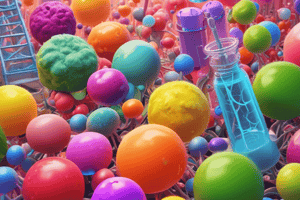Podcast
Questions and Answers
What is the primary function of metabolism?
What is the primary function of metabolism?
To derive energy and raw materials from food and use them to support repair, growth, and activity of tissues.
Which of the following is a form of energy work performed by cells?
Which of the following is a form of energy work performed by cells?
- Biosynthetic
- Transport
- Mechanical
- All of the above (correct)
What are the two main processes of metabolism?
What are the two main processes of metabolism?
- Absorption and Assimilation
- Catabolism and Anabolism (correct)
- Digestion and Excretion
- Oxidation and Reduction
Match the nutrients with their description:
Match the nutrients with their description:
Energy intake exceeding expenditure will lead to a decrease in body weight.
Energy intake exceeding expenditure will lead to a decrease in body weight.
What are exergonic reactions?
What are exergonic reactions?
What is the role of the ATP/ADP cycle in metabolism?
What is the role of the ATP/ADP cycle in metabolism?
What is the concentration of glucose in fasting blood plasma?
What is the concentration of glucose in fasting blood plasma?
What happens to energy stores if expenditure exceeds intake?
What happens to energy stores if expenditure exceeds intake?
Flashcards are hidden until you start studying
Study Notes
Overview of Nutrient Metabolism
- Metabolism involves processes that derive energy and raw materials from food, supporting repair, growth, and activity of body tissues.
- Essential components of nutrient metabolism include the roles of the gastrointestinal tract (GIT), blood, and tissues in nutrient conversion, storage, utilization, and waste elimination.
Metabolic Energy
- All living organisms utilize energy to combat entropy, support growth, repair cells, and maintain body temperature in endothermic species (e.g., mammals and birds).
- Energy types used by cells include biosynthetic, transport, mechanical, and electrical work.
Raw Materials and Nutritional Requirements
- Body constituents are produced from basic materials sourced from the diet, necessitating essential nutrients that undergo interconversion through energy expenditure.
Metabolic Processes
- Two main metabolic processes:
- Catabolism: The breakdown of large molecules into smaller ones to release energy.
- Anabolism: The use of energy to synthesize molecules necessary for growth and maintenance.
Chemical Bond Energy
- Chemical reactions involve the breaking and formation of chemical bonds, with exergonic reactions releasing more energy than they consume and endergonic reactions requiring more energy than they produce.
Coupling and the ATP-ADP Cycle
- Metabolic processes couple the energy released from exergonic reactions to the energy required for endergonic reactions through an intermediate process, notably the ADP/ATP cycle.
Nutritional Intake
- Average food consumption is approximately 500 kg per year, providing energy, building blocks (amino acids, carbohydrates, lipids), specific nutrients (vitamins, minerals), water, and fibers.
Blood as a Transport Medium
- Blood carries nutrients from the diet to tissues for utilization, storage, interconversion, and transports produced materials and waste products for excretion.
Blood Concentrations and Nutrient Regulation
- The concentration of substances in blood is maintained at constant levels despite fluctuating nutrient supply and variable demand, with tissues capable of nutrient storage and interconversion.
Tissue Functions Related to Nutrients
- Kidneys: No storage, can interconvert and utilize nutrients.
- Liver: Stores, interconverts, and utilizes nutrients.
- Adipose tissue: Stores but does not interconvert, utilizes nutrients.
- Skeletal muscle, heart muscle, brain: Primarily utilize nutrients without storage or interconversion.
Fasting Blood Plasma Composition
- Typical concentrations during fasting include:
- Glucose: 5 mmol/l
- Amino acids: 2 mmol/l
- Triacylglycerol: 2 mmol/l
- Cholesterol: 5 mmol/l
- Fatty acids: 0.5 mmol/l
- Lactate and pyruvate: Found in 97% of the population.
Energy Balance and Body Weight
- Body weight remains stable when energy intake matches expenditure.
- If energy intake exceeds expenditure, body weight increases due to energy storage.
- When expenditure exceeds intake, energy reserves are depleted first, followed by the utilization of body components primarily composed of protein for energy.
Body Composition Insights
- Illustrates differences in body composition based on weight, emphasizing importance of carbohydrate, protein, and fat in overall body structure and health.
Studying That Suits You
Use AI to generate personalized quizzes and flashcards to suit your learning preferences.




